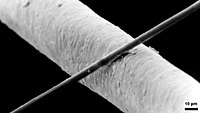
Photo from wikipedia
Hydroxyapatite (HA)-based composite bone scaffolds are developed using solvent casting particulate leaching technique by varying the weight percentages of HA from 50 to 70% (w/w) in polymethyl methacrylate matrix. The… Click to show full abstract
Hydroxyapatite (HA)-based composite bone scaffolds are developed using solvent casting particulate leaching technique by varying the weight percentages of HA from 50 to 70% (w/w) in polymethyl methacrylate matrix. The chemical properties of the developed scaffolds are investigated by XRD analysis which shows the presence of crystalline HA and traces of β-TCP in the scaffolds. The microstructure of the scaffolds is studied by the SEM micrographs, which show porous morphology with an average pore size of 119 ± 18–148 ± 23 µm and a maximum pore size of 148 ± 23 µm for HA 50 scaffold. The highest porosity of 75 ± 2.0% is recorded for HA 50 scaffold by conducting liquid displacement test and a maximum compressive strength of 6.26 ± 0.53 MPa is recorded for HA 60 scaffold by performing uniaxial compression test of the scaffolds. The permeability and wall shear stress (WSS) of the scaffolds are investigated by computational fluid dynamics (CFD). The CFD analysis is performed in a fluid domain developed by Boolean operations on the CAD model of the scaffold developed using micro-computed tomography-based 3D image acquisition technique by Mimics V1. Results show that the permeability increases and WSS decreases with an increase in the porosity of the scaffolds. However, both permeability and WSS obtained for the developed scaffolds are within the limit prescribed for the growth of bone tissues. It is concluded that scaffolds with 60 wt% of HA exhibit the best combination of porosity, permeability and compressive strength making it suitable for bone tissue engineering applications.
Journal Title: Arabian Journal for Science and Engineering
Year Published: 2020
Link to full text (if available)
Share on Social Media: Sign Up to like & get
recommendations!